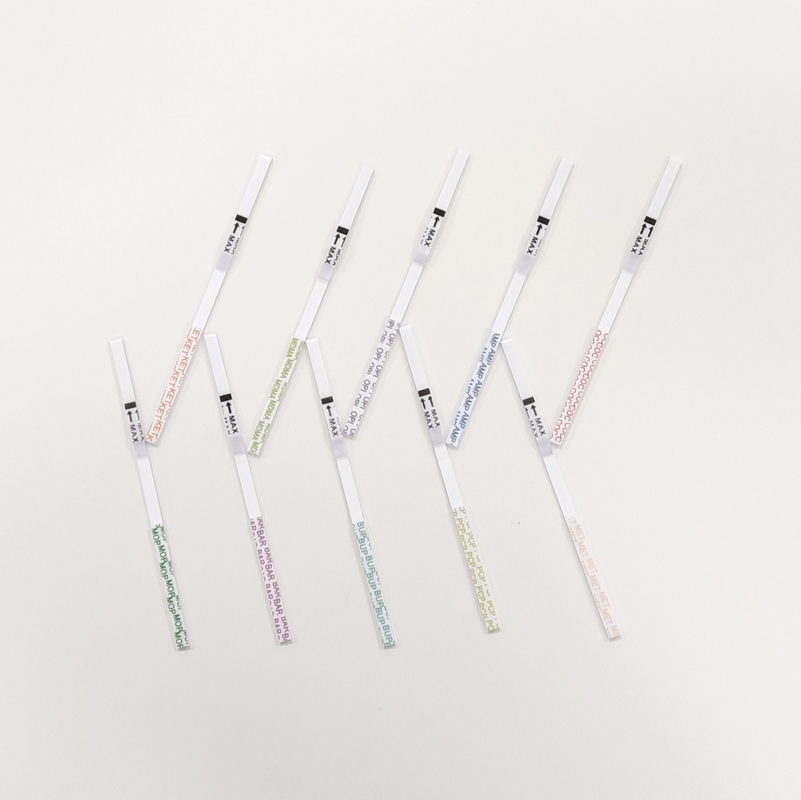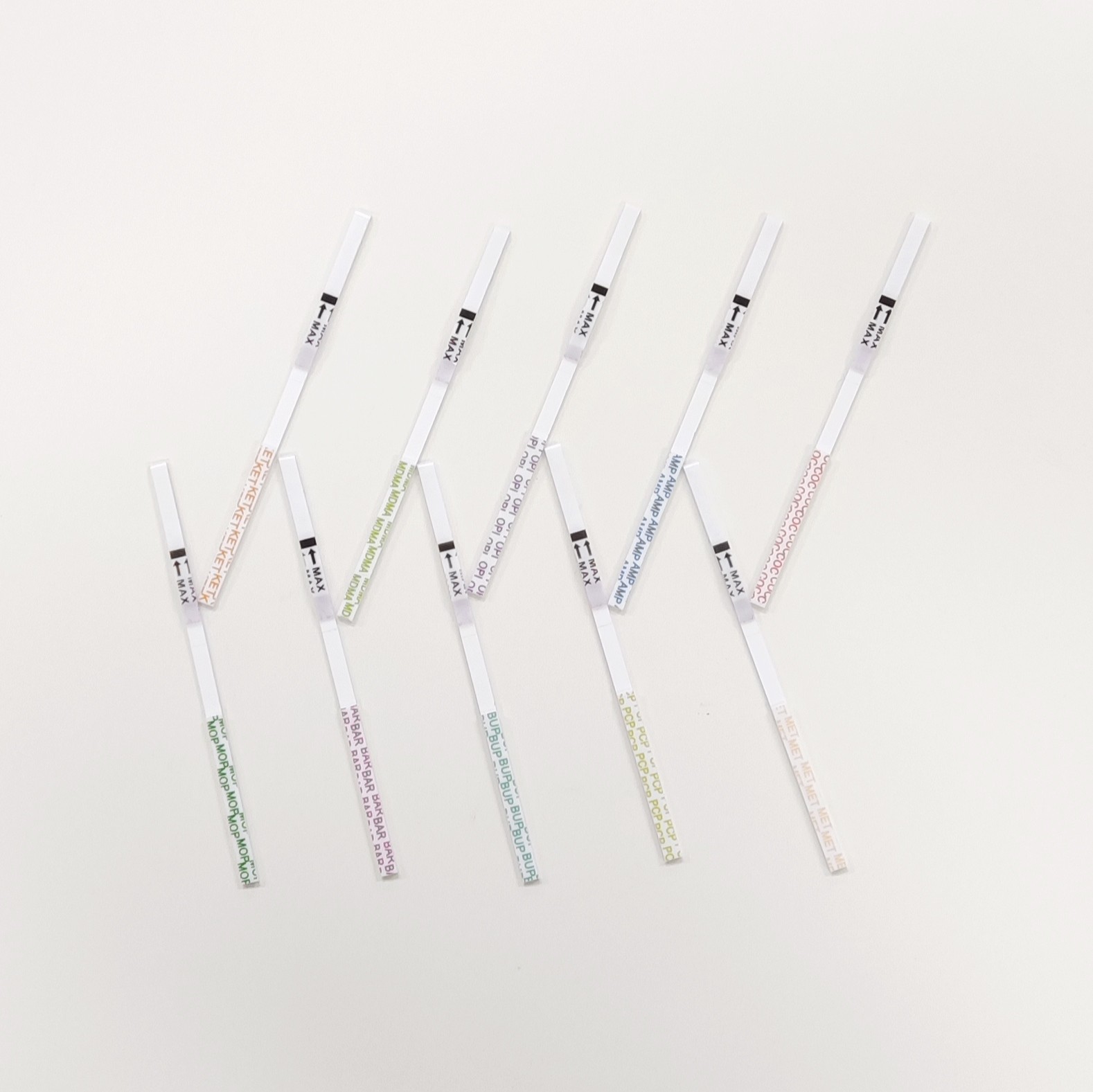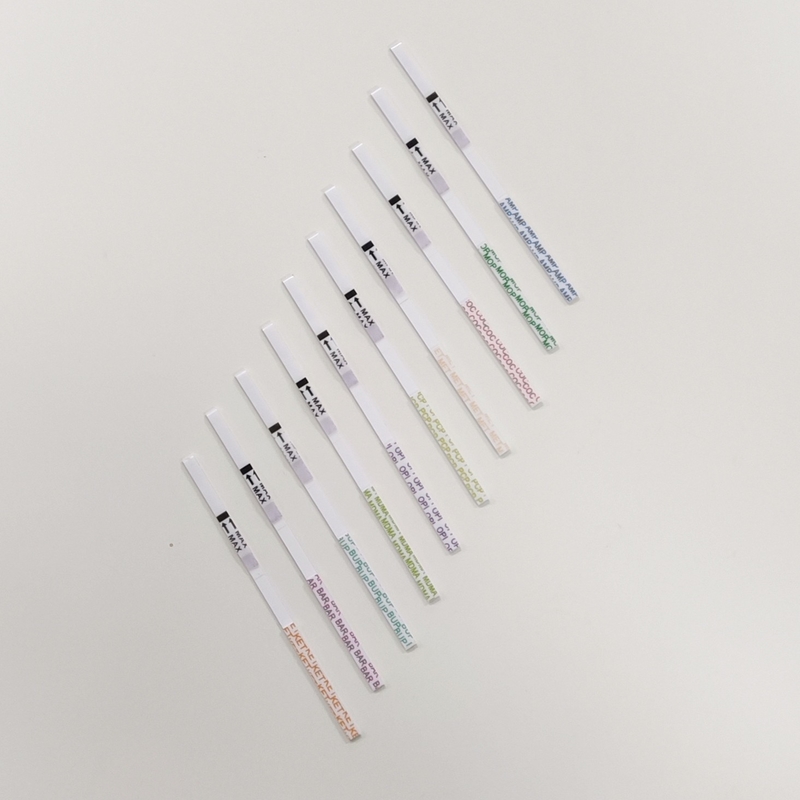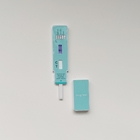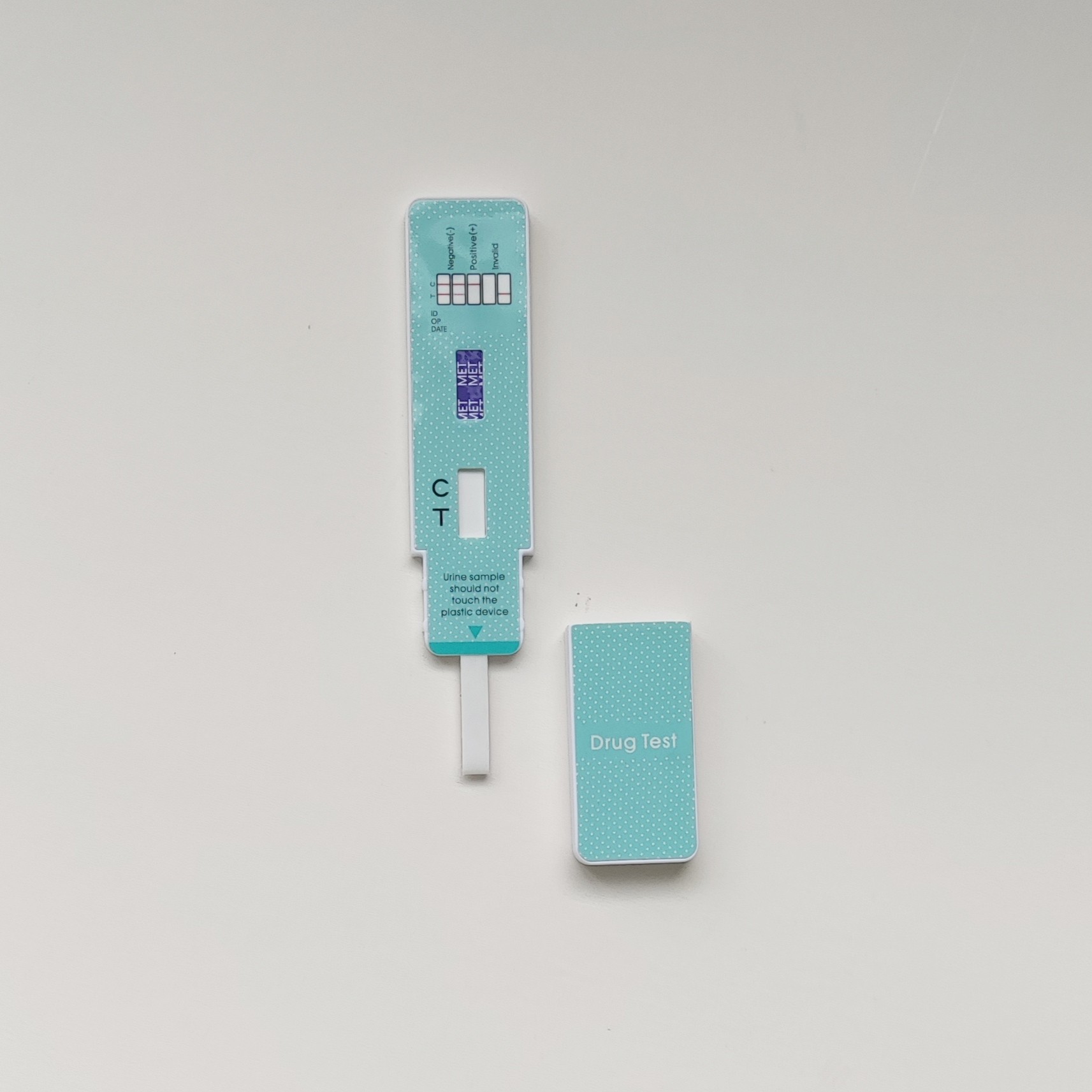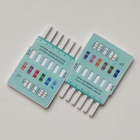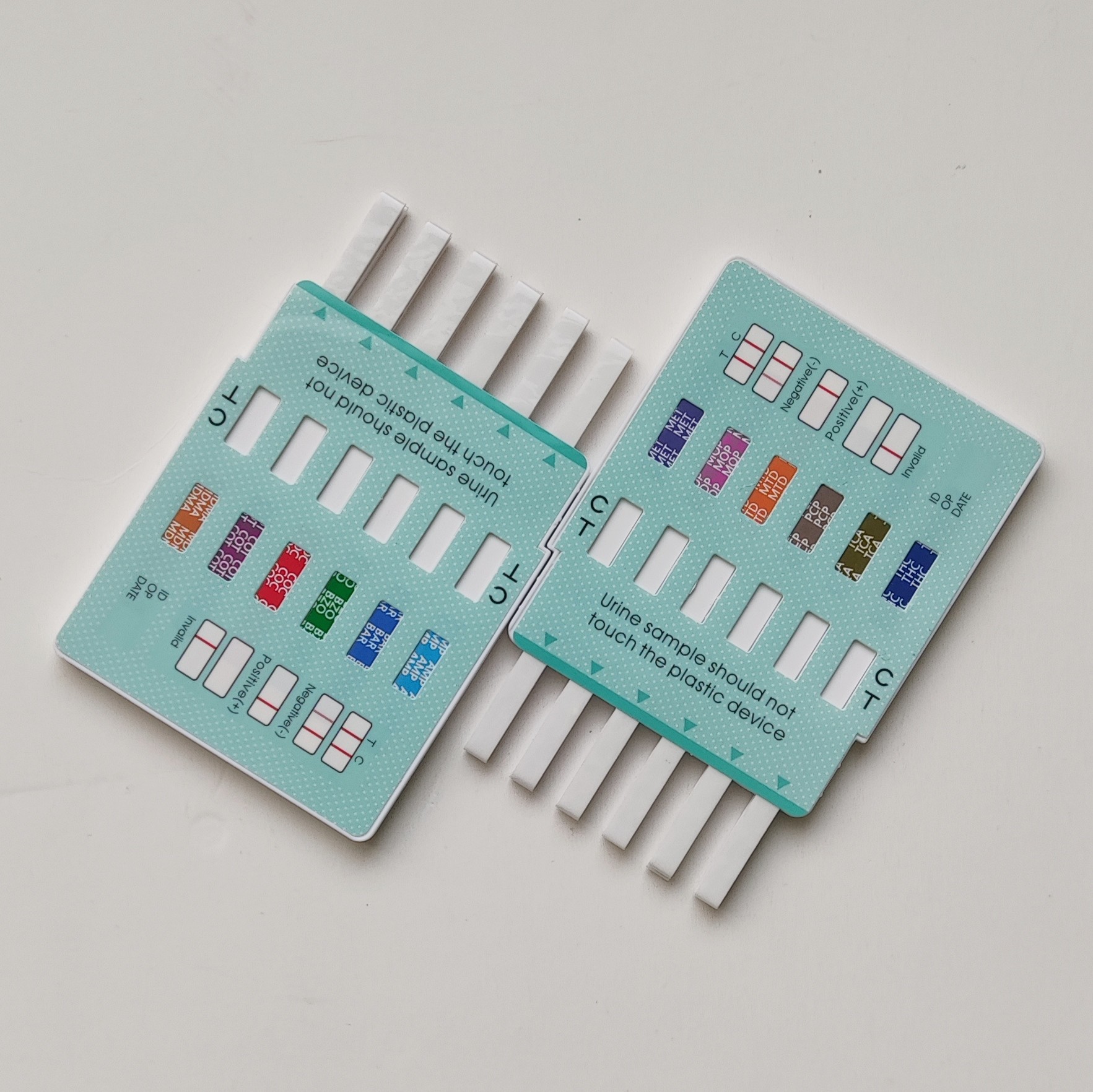Rapid Test Kit Multi-Drug 13-15 Drug of Abuse Test Diagnostic Test Strip Cup Cassette
13-15 combination of the following drugs:
AMP/ BAR/ BUP/ BZO/ COC/ COT/ ETG/ FYL/ K2/ KET/ MAM/ MET/ MOP300/ MQL
Rapid Multi-Drug 13-15 Test is a rapid, screening test for the qualitative detection of multiple drugs and drug metabolites in human urine at specified cut off levels.
For professional use only. For in vitro diagnostic use only.
【INTENDED USE】
Rapid Multi-Drug 13-15 Test is an immuno-chromatographic assay for the qualitative determination of the presence of drugs listed in the table below.
| Drug(Identifier) |
Calibrator |
Cut-off level |
| AMP |
d-Amphetamine |
1000ng/mL |
| BAR |
Secobarbital |
300 ng/mL |
| BUP |
Buprenorphine1 |
10 ng/mL |
| BZO |
Oxazepam |
300 ng/mL |
| COC |
Benzoylecgonine |
300 ng/mL |
| COT |
Cotinine |
200 ng/mL |
| ETG |
Ethyl -glucuronide |
500 ng/mL |
| FYL |
Fentanyl1 |
200 ng/mL |
| K2 |
JWH-018PantanoicAcid |
50 ng/mL |
| KET |
Ketamin |
1000ng/mL |
| 6-MAM |
6-Aoetylmorphine |
10 ng/mL |
| MDMA1 |
3,4-Methylenedioxymethamphetamine HCl (MDMA1) |
500 ng/mL |
| MET |
d-MET |
1000ng/mL |
| MOP/MOR |
Morphine1 |
300ng/mL |
| MQL |
Methaqualone1 |
300ng/mL |
The test you purchased may test for any combination of drugs listed in the table above. This assay provides only a preliminary analytical test result. Gas Chromatography/Mass spectrometry (GC/MS) is the preferred confirmatory method. Clinical consideration and professional judgment should be applied to any drug of abuse test result, particularly when preliminary positive results are indicated.
【SUMMARY】
AMP and the structurally related “designer” drugs are sympathomimetic amines whose biological effects include potent central nervous system (CNS) stimulation, anorectic, hyperthemic , and cardiovascular properties. They are usually taken orally, intraveneously, or by smoking. Amphetamines are readily absorbed from the gastrointestinal tract and are then either deactivated by the liver or excreted unchanged in the urine. Methamphetamineis partially metabolized to amphetamine and its major active metabolite. Amphetamines increase the heart rate and blood pressure, and suppress the appetite. Some studies indicate that heavy abuse may result in permanent damage to certain essential nerve structural in the brain.The effects of Amphetamines generally last 2-4 hours following use and the drug has a half-life of 4-24 hours in the body. About 30% of amphetamines are excreted in the urine in unchanged form, with the remainder as hydroxylated and deaminated derivatives.It can be detected in the urine for 1 to 2 days after use.
BAR is central nervous system depressant. It is usually administered orally but are sometimes injected intramuscularly and intravenously. Barbiturates range from short-acting (approximately 15 minutes, such as secobarbital) to long-acting (24 hours or longer, such asPhenobarbital). Short-acting barbiturates are extensively metabolized in the body, while the long-acting ones are secreted primarily unchanged. Barbiturates produce alertness, wakefulness, increased energy, reduced hunger, and an overall feeling of well being. Large doses of Barbiturate could develop tolerance and physiological dependency and lead to its abuse.
BUP is a potent analgesic often used in the treatment of opioid addiction. The drug is sold under the trade names Subutex™, Buprenex™, Temgesic™ and Suboxone™, which contain BUP HCl alone or in combination with Naloxone HCl. Therapeutically, BUP is used as a substitution treatment for opioid addicts.Substitution treatment is a form of medical care offered to opiate addicts (primarily heroinaddicts) based on a similar or identical substance to the drug normally used. In substitution therapy, BUP is as effective as MTD but demonstrates a lower level of physical dependence. Concentrations of free BUP and Norbuprenorphinein urine may be less than 1 ng/ml after therapeutic administration, but can range up to 20 ng/ml in abuse situations.3 The plasma half life of BUP is 2-4 hours.3 While complete elimination of a single dose of the drug can take as long as 6 days, the window of detection for the parent drug in urine is thought to be approximately 3 days. Substantial abuse of BUP has also been reported in many countries where various forms of the drug are available. The drug has been diverted from legitimate channels through theft, doctor shopping, and fraudulent prescriptions, and been abused via intravenous, sublingual, intranasal and inhalation routes.
BZO is a class of drugs that are often therapeutically used as anxiolytics, anti-convulsants and sedative hypnotics. BZO manifest their presence by analgesia, drowsiness, confusion, diminished reflexes, lowering of body temperature, respiratory depression, blockade of adrenocortical response, and a decrease in peripheral resistance without an impact on the cardiac index. The major pathways of elimination are the kidneys (urine) and the liver where it is conjugated to glucuronic acid. Large doses of BZO could develop tolerances and physiological dependency and lead to its abuse. Only trace amounts (less than 1%) of BZO are excreted unaltered in the urine, most of BZO in urine is conjugated drug. Oxazepam, a common metabolite of many BZO, remains detectable in urine for up to one week, which makes Oxazepam a useful marker of BZO abuse.
COC derived from leaves of coca plant, is a potent central nervous system stimulant and a local anesthetic. Among the psychological effects induced by using cocain are euphoria, confidence and a sense of increased energy, accompanied by increased heart rate, dilation of the pupils, fever, tremors and sweating. COC is excreted in urine primarily as benzoylecgonine in a short period of time.
COT is the first-stage metabolite of nicotine, a toxic alkaloid that produces stimulation of the autonomic ganglia and central nervous system when in humans. Nicotine is a drug to which virtually every member of a tobacco-smoking society is exposed whether through direct contact or second-hand inhalation. In addition to tobacco, nicotine is also commercially available as the active ingredient in smoking replacement therapies such as nicotine gum, transdermal patches and nasal sprays. In a 24-hour urine, approximately 5% of a nicotine dose is excreted as unchanged drug with 10% as cotinine and 35% as hydroxycotinine; the concentrations of other metabolites are believed to account for less than 5%. While cotinine is thought to be an inactive metabolite, it’s elimination profile is more stable than that of nicotine which is largely urine pH dependent. As a result, cotinine is considered a good biological marker for determining nicotine use.
ETG is a direct metabolite of alcohol. Presence in urine may be used to detect recent alcohol intake, even after alcohol is no longer measurable. Traditional laboratory methods detect the actual alcohol in the body, which reflects current intake within the past few hours (depending on how much was consumed). The presence of EtG in urine is a definitive indicator that it can be detected in the urine for 3 to 4 days after drinking alcohol, even alcohol is eliminated from the body. Therefore, EtG is a more accurate indicator of the recent intake of alcohol than measuring for the presence of alcohol itself. The EtG test can aid in the diagnosis of drunk driving and alcoholism, which has important significance in the forensic identification and medical examination.
FYL is a potent, synthetic narcotic analgesic with a rapid onset and short duration of action. It is a strong agonist at the μ-opioid receptors. Historically it has been used to treat breakthrough pain and is commonly used in pre-procedures as a pain reliever as well as an anesthetic in combination with a benzodiazepine. It is approximately 80 to 100 times more potent than MOP and roughly 15 to 20 times more potent thanheroin.
K2: Since 2004, herbal mixtures such as ‘Spice’ are sold in Switzerland, Austria, Germany and other European countries mainly via Internet shops. Although declared as incense, they are smoked as ‘bio-drugs’ by the consumers. In corresponding blogs, drug users reported cannabislike effects after smoking. These products enjoy great popularity particularly among younger people, as up to now the mixtures are sold in head shops and via internet in many countries without age restriction. JWH-018was developed and evaluated in basic scientific research to study structure activity relationships related to the cannabinoid receptors. JWH073 has been identified in numerous herbal products, such as “Spice”, “K2”, K3” and others. These products may be smoked for their psychoactive effects.
KET is a short-acting “dissociative” anesthetic due to its ability to separate perception from sensation. It also has hallucinogenic and painkilling qualities that seem to affect people in very different ways. Ketamin is chemically related to PCP (’Angel Dust’). Ketamin is occasionally administered to people but, more commonly, is used by vets for pet surgery. Generally street K is most often diverted in liquid form from vets’ offices or medical suppliers. Ketamin generally takes 1-5 minutes to take effect. Snorted ketamin takes a little longer at 5-15 minutes. Depending on how much and how recently one has eaten, oral ketamin can take between 5 and 30 minutes to take effect. The primary effects of ketamin last approximately an 30-45 minutes if injected, 45-60 minutes when snorted, and 1-2 hours if used orally. The Drug Enforcement Administration reports that the drug can still affect the body for up to 24 hours.
6-MAM or 6-acetylmorphine (6-AM) is one of three active metabolites ofheroin (diacetylmorphine), the others being MOP and the much less active 3-monoacetylmorphine (3-MAM). 6-MAM is rapidly created fromheroin in the body, and then is either metabolized into MOP or excreted in the urine. 6-MAM remains in the urine for no more than 24 hours. So a urine specimen must be collected soon after the lastheroin use, but the presence of 6-MAM guarantees thatheroin was in fact used as recently as within the last day. 6-MAM is naturally found in the brain, but in such small quantities that detection of this compound in urine virtually guarantees thatheroin has recently been consumed.
MDMAbelongs to a family of man-made drugs. Its relatives include Methylenedioxyamphetamine, and MDEA (methylenedioxyethylamphetamine). They all share the amphetamine-like effects. MDMAis a stimulant with hallucinogenic tendencies described as an empathogen as it releases mood-altering chemicals, such as cartooning and L-dopa, and may generate feelings of love and friendliness. The adverse effects ofMDMA use include elevated blood pressure, hyperthermia, anxiety, paranoia and insomnia. MDMAis administered either by oral ingestion or intravenous injection. The effects ofMDMA begin 30 minutes after intake, peak in an hour and last for 2 – 3 hours.
MET is a potent sympathomimetic agent with therapeutic applications. Acute higher doses lead to enhanced stimulation of the central nervous system and induce euphoria, alertness, and a sense of increased energy and power. More acute responses produce anxiety, paranoia, psychotic behavior, and cardiac dysrhythmias. The pattern of psychosis which may appear at half-life of about 15 hours is excreted in urine as amphetamine and oxidized as deaminated and hydroxylated derivatives. However, 40% ofmethamphetamine is excreted unchanged. Thus the presence of the parent compound in the urine indicates methamphetamineuse.
MOP/MOR
Opiates refer to any drug that is derived from the opiumpoppy, including the natural products, Morphineandcodeine, and the semi-synthetic drugs such asheroin. Opiates exert their effects on the central nervous system and organs containing smooth muscle. Opiates manifest their presence by analgesia, drowsiness, euphoria, lowering of body temperature, respiratory depression, blockade of adrenocortical response. The major pathways of elimination are kidneys (urine) and the liver where it is conjugated to glucuronic acid. Opiates and their metabolites can be detected in urine as result ofheroin, MOP, codeineorpoppy seed intake.
MQL is a sedative and hypnotic medication. MQL is a depressant that increases the activity of the GABA receptors in the brain and nervous system. When GABA activity is increased, blood pressure drops and the breathing and pulse rates slow, leading to a state of deep relaxation. MQL peaks in the bloodstream within several hours, its effects generally lasting four to eight hours. Regular users build up a physical tolerance, requiring larger doses for the same effect. Overdose can lead to nervous system shut down, coma and death.
【PRINCIPLE】
Rapid Single/multi-drug Test Cassette is a competitive immunoassay that is used to screen for the presence of various drugs and drug metabolites in urine. It is chromatographic absorbent device in which, drugs within a urine sample, competitively combined to a limited number of drug monoclonal antibody (mouse) conjugate binding sites.
When the test is activated, the urine is absorbed into each test strip by capillary action, mixes with the respective drug monoclonal antibody conjugate, and flows across a pre-coated membrane. When drug within the urine sample is below the detection level of the test, respective drug monoclonal antibody conjugate binds to the respective drug-protein conjugate immobilized in the Test Region (T) of the test strip. This produces a colored Test line in the Test Region (T) of the strip, which, regardless of its intensity, indicates a negative test result.
When sample drug levels are at or above the detection level of the test, the free drug in the sample binds to the respective drug monoclonal antibody conjugate, preventing the respective drug monoclonal antibody conjugate from binding to the respective drug-protein conjugate immobilized in the Test Region (T) of the device. This prevents the development of a distinct colored band in the test region, indicating a preliminary positive result.
To serve as a procedure control, a colored line will appear at the Control Region (C), of each strip, if the test has been performed properly.
【CONTENTS】
- Drug Test..
- Desiccant
- Leaflet with instruction for use.
【STORAGE AND STABILITY】
- The kit should be stored at 2-30°C until the expiry date printed on the sealed pouch.
- The test must remain in the sealed pouch until use.
- Keep away from direct sunlight, moisture and heat.
- Do not freeze.
- Care should be taken to protect the components of the kit from contamination. Do not use if there is evidence of microbial contamination or precipitation. Biological contamination of dispensing equipment, containers or reagents can lead to false results.
【OPERATION】
Test must be in room temperature (15ºC to 30ºC)
- Donor collects urine specimen in a urine cup.
- Open the sealed pouch by tearing along the notch. Remove the test cassette from the pouch and place it on a level surface.
- Hold the sample dropper vertically, and add exactly three drops of the urine specimen into the sample well.
- The result should be read at 5 minutes. Do not interpret the result after 10 minutes. See the illustration below.
【SPECIMEN COLLECTION AND PREPRATION】
- Collect urine sample with a clean, dry container. Urine collected at any time of the day may be used.
- For best results, test specimens immediately following collection.
- Urine specimens may be refrigerated (2-8°C) and stored up to forty-eight hours.
- For longer storage, freeze the samples (-20°C or below).
- Bring frozen or refrigerated samples to room temperature before testing.
【OPERATION】
Test must be in room temperature (15ºC to 30ºC)
- Donor collects urine specimen in a urine cup.
- Open the sealed pouch by tearing along the notch. Remove the test cassette from the pouch and place it on a level surface.
- Hold the sample dropper vertically, and add exactly three drops of the urine specimen into the sample well.
- The result should be read at 5 minutes. Do not interpret the result after 10 minutes. See the illustration below.





 Your message must be between 20-3,000 characters!
Your message must be between 20-3,000 characters! Please check your E-mail!
Please check your E-mail!  Your message must be between 20-3,000 characters!
Your message must be between 20-3,000 characters! Please check your E-mail!
Please check your E-mail! 

